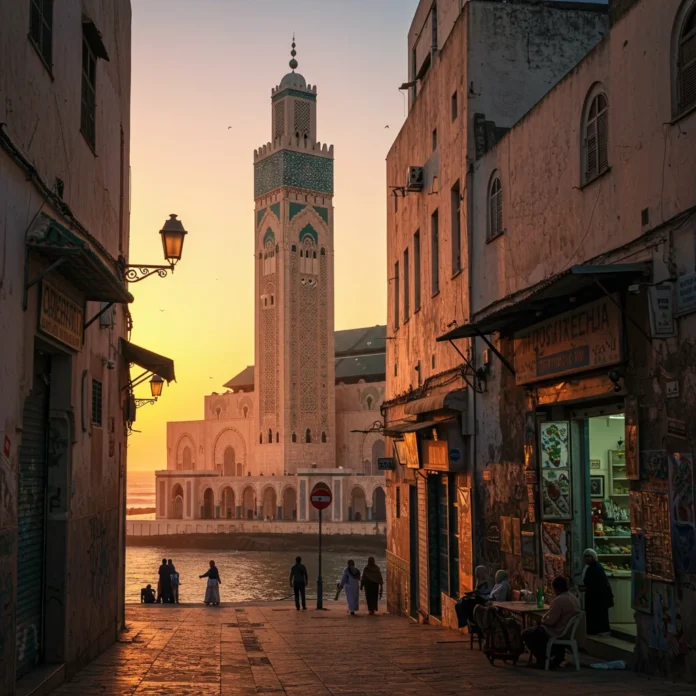Introduction to Casablanca: Morocco’s Coastal Gem
Along the Atlantic shoreline, Casablanca pulses with a unique blend of tradition and modernity. The city’s salty sea breeze mingles with the aroma of fresh bread and spices, creating an atmosphere that is both invigorating and inviting. As Morocco’s largest metropolis, Casablanca offers an energetic urban landscape set against the backdrop of its storied past and cosmopolitan present.
From the monumental Hassan II Mosque to bustling boulevards and tranquil seaside promenades, Casablanca invites us to experience Morocco’s cultural diversity in every sense—sight, sound, and flavor.
Why Visit Casablanca? Top Reasons to Explore
Casablanca attracts travelers for its striking architecture, lively markets, and dynamic culinary scene. As the economic heart of Morocco, it balances business with leisure, offering world-class shopping, vibrant nightlife, and historical treasures.
The city’s allure lies in its ability to surprise—with hidden Art Deco gems, sunlit seafronts, and a hospitality that welcomes visitors from around the globe. Whether we are seeking spiritual marvels, shopping adventures, or a taste of authentic Moroccan life, Casablanca delivers a rich, multi-layered experience.
A Brief History of Casablanca
Casablanca’s story is one of resilience and transformation. From its humble beginnings as a small Berber settlement known as Anfa, it has grown into a global metropolis without losing its original character.
How Has Casablanca Evolved Over the Years?
Over centuries, Casablanca has been shaped by Berber tribes, Portuguese colonists, and French urban planners. The city was rebuilt after the 1755 Lisbon earthquake and underwent rapid modernization during the French Protectorate. Today, its skyline reflects this layered past—where minarets stand beside Art Deco facades and sleek glass towers.
Casablanca’s Role in Modern Morocco
As Morocco’s economic powerhouse, Casablanca leads in finance, industry, and innovation. The city is home to the country’s largest port, international corporations, and cultural institutions. Its influence extends beyond commerce, shaping national identity and serving as a gateway to Morocco for millions of visitors each year.
Getting to Casablanca: Travel Tips
Arriving in Casablanca is straightforward thanks to its robust transport infrastructure. The city is served by Mohammed V International Airport, extensive rail connections, and a network of highways.
Which Is the Best Time to Visit Casablanca?
Casablanca enjoys a mild Mediterranean climate, with warm summers and gentle winters. The most pleasant months for travel are April through June and September through November, when temperatures are comfortable and the Atlantic breeze keeps the city fresh.
Navigating Casablanca: Transportation Guide
The city’s tramway, taxis, and rideshare services make getting around easy. For a smooth arrival, many visitors opt for private transfers, which can save time and provide peace of mind. We’ve outlined practical advice for seamless airport arrivals in our post on private transfer options in Casablanca.
Hassan II Mosque: The Crown Jewel of Casablanca
The Hassan II Mosque rises dramatically above the Atlantic, its minaret gleaming in the sunlight. As one of the world’s largest mosques, it is a masterpiece of Moroccan craftsmanship and a symbol of Casablanca’s spiritual and architectural heritage.
A Brief History of Hassan II Mosque
Commissioned by King Hassan II, the mosque was envisioned as a monument to faith and national pride. Its construction brought together thousands of artisans and craftsmen from across Morocco.
Who Designed the Hassan II Mosque?
The mosque was designed by French architect Michel Pinseau, who worked closely with Moroccan artisans to harmonize modern engineering with traditional aesthetics. The result is a structure that feels both timeless and innovative.
When Was the Mosque Built?
Construction began in 1986 and concluded in 1993, culminating in an inauguration attended by dignitaries from around the world. The mosque’s opening marked a new chapter in Casablanca’s architectural narrative.
Architectural Marvels: What Makes the Mosque Unique?
The Hassan II Mosque captivates with its sheer scale and exquisite detail. Its minaret, intricate mosaics, and oceanfront setting create a sense of awe that lingers long after our visit.
Stunning Minaret: The Tallest in the World?
At 210 meters, the mosque’s minaret is the tallest in the world. It towers above the city, serving as a beacon for worshippers and a landmark visible from miles away.
Intricate Tilework and Artistry
The mosque’s walls and ceilings are adorned with zellij tilework, carved plaster, and hand-painted wood. Sunlight streams through stained glass, casting vibrant patterns across the prayer hall’s marble floors.
The Glass Floor Over the Atlantic
One of the mosque’s most distinctive features is its glass floor section, which allows visitors to gaze directly onto the rolling Atlantic waves below. This unique design element connects the spiritual and natural worlds in a breathtaking display.
Visiting the Hassan II Mosque: What to Know
The mosque welcomes visitors of all backgrounds, offering guided tours in several languages. Its serene courtyards and sweeping ocean views make it a must-see for any traveler in Casablanca.
Tour Schedules and Ticketing
Guided tours operate at set times each day, with tickets available on-site or through official channels. For a seamless experience, consider a premium skip-the-line tour—as detailed in our guide to exclusive Hassan II Mosque access.
Dress Code and Visitor Etiquette
Modest attire is required; shoulders and knees should be covered. Shoes must be removed before entering the prayer hall, and respectful behavior is expected throughout the visit.
Guided vs. Self-Guided Tours: Which to Choose?
Guided tours provide valuable insights into the mosque’s history and symbolism, while self-guided visits offer more flexibility. Both options allow us to appreciate the mosque’s grandeur at our own pace.
Photography Tips Inside the Mosque
Photography is permitted in most areas, but flash and tripods are discouraged. The best times for photos are early morning or late afternoon, when soft light enhances the mosque’s intricate details and shimmering mosaics.
Religious Significance and Cultural Impact
The Hassan II Mosque is not only a place of worship but also a center for cultural exchange and education. Its doors are open to visitors, fostering understanding and appreciation of Morocco’s rich Islamic heritage.
Can Non-Muslims Visit the Mosque?
Unlike many mosques in Morocco, the Hassan II Mosque welcomes non-Muslim visitors during designated tour times, making it an accessible and enlightening experience for all.
Special Events and Ramadan at the Mosque
During Ramadan and special religious occasions, the mosque hosts large gatherings and communal prayers, filling the air with the melodic sound of the call to prayer and the scent of incense.
Nearby Attractions Around Hassan II Mosque
The mosque’s location offers easy access to some of Casablanca’s most vibrant neighborhoods and popular coastal spots.
The Corniche: Casablanca’s Vibrant Seafront
Just a short walk away, the Corniche stretches along the Atlantic with lively cafés, sandy beaches, and panoramic ocean views. The sound of waves and laughter fills the air, making it a favorite spot for locals and visitors alike.
Rick’s Café: Inspired by the Iconic Film
Step into cinematic history at Rick’s Café, a recreation of the legendary bar from “Casablanca.” With its jazz melodies, Art Deco interiors, and classic cocktails, it transports guests to the golden age of Hollywood glamour.
Exploring the Old Medina of Casablanca
The Old Medina offers a labyrinth of narrow alleys, whitewashed walls, and bustling souks. It is a place where the city’s ancient heart beats strongest, filled with the sounds of merchants, laughter, and distant calls to prayer.
What Is the Old Medina Like Today?
While much of Casablanca is modern, the Old Medina preserves its traditional character. Here, we encounter historic gates, crumbling ramparts, and vibrant street life that reflect centuries of change.
Historic Landmarks in the Medina
Landmarks such as Bab Marrakech gate and the colonial-era clock tower stand as reminders of the city’s layered history. The Medina’s winding streets invite us to slow down and absorb its timeless charm.
Best Souks and Shopping Spots
The souks brim with textiles, spices, and handcrafted goods. Bargaining is part of the experience, and the scent of leather, saffron, and fresh mint fills the air.
Local Eateries and Street Food
Street vendors offer everything from sizzling kebabs to sweet pastries. Sampling a warm msmen or a glass of fresh orange juice is a simple pleasure not to be missed.
City Secrets: Hidden Gems of Casablanca
Beyond the main sights, Casablanca hides treasures that reward the curious. These lesser-known spots offer insight into the city’s creative and architectural soul.
La Sqala: Fortress Turned Café
Set within an 18th-century fortress, La Sqala offers tranquil gardens and a menu of Moroccan classics. The scent of orange blossom and grilled fish drifts through shaded courtyards, creating an oasis of calm in the city’s heart.
Villa des Arts: Casablanca’s Creative Hub
The Villa des Arts hosts contemporary art exhibitions and cultural events, fostering creativity and dialogue. Its Art Deco architecture and serene gardens provide an inspiring setting for both artists and visitors.
The Mahkama du Pacha: Architectural Splendor
This judicial building dazzles with its carved cedar ceilings, marble columns, and ornate tilework. Guided tours reveal stories of Casablanca’s legal and political history, along with breathtaking examples of Moroccan artistry.
Sacré-Cœur Cathedral: Casablanca’s Forgotten Monument
The Sacré-Cœur Cathedral, with its neo-Gothic spires and stained glass, stands as a poignant reminder of Casablanca’s colonial past. Though no longer consecrated, it occasionally hosts exhibitions and concerts, filling its echoing halls with art and music.
The Habous Quarter: A Blend of Old and New
Built in the 1930s, the Habous Quarter combines traditional Moroccan design with modern urban planning. Its wide boulevards, graceful arches, and bustling markets create a harmonious balance between past and present.
What Makes the Habous Quarter Unique?
The quarter is famous for its orderly streets, elegant architecture, and welcoming atmosphere. It is a favorite destination for those seeking authentic crafts, pastries, and books.
Traditional Bakeries and Pastry Shops
The aroma of fresh kaab el ghazal and honey-soaked chebakia fills the air. Bakeries here are renowned for their artisanal treats, prepared using time-honored recipes.
Bookstores and Artisan Boutiques
Shelves overflow with calligraphy, poetry, and rare manuscripts. Artisan shops display ceramics, leather goods, and handwoven textiles, each piece telling a story of local heritage.
Moroccan Tea Houses and Cafés
Tea houses serve fragrant mint tea in delicate glasses, while the gentle hum of conversation and clinking of spoons create a soothing backdrop for relaxation and reflection.
Modern Casablanca: Skyscrapers and Business Districts
Casablanca’s skyline is defined by sleek glass towers, luxury hotels, and bustling commercial centers. The city’s business districts pulse with energy, ambition, and innovation.
Casablanca Finance City: Africa’s Economic Hub
As a leading financial center, Casablanca Finance City attracts multinational corporations and investment from across the continent. Its modern infrastructure and dynamic workforce position the city at the forefront of African business.
The Twin Center: Shopping and Dining
The Twin Center towers house designer boutiques, gourmet restaurants, and panoramic sky bars. Here, we can enjoy sweeping views of the city while savoring international cuisine or browsing for the latest fashions.
Art and Culture in Casablanca
Casablanca’s cultural scene is vibrant, with museums, galleries, and festivals celebrating the city’s artistic spirit. From contemporary installations to traditional crafts, there is inspiration at every corner.
Museums and Galleries You Shouldn’t Miss
The Museum of Moroccan Judaism and the Villa des Arts offer thought-provoking exhibitions, while smaller galleries showcase emerging talent from Morocco and beyond.
For travelers interested in exploring similar cultural wonders in other cities, our post about Istanbul’s iconic sites and hidden gems provides further inspiration.
Annual Festivals and Events
Casablanca comes alive with music, film, and food festivals throughout the year. These events draw crowds from across Morocco and the world, infusing the city with color, rhythm, and excitement.
Live Music and Nightlife Scene
From jazz clubs to rooftop lounges, Casablanca’s nightlife is as diverse as its population. Live music fills the air, and the city’s energy is palpable well into the night.
As experts often say:
“Casablanca is a city that never sleeps—its creativity, passion, and hospitality shine brightest after sunset.”
Casablanca’s Culinary Scene: Where to Eat
The city’s culinary scene reflects its cosmopolitan character, offering everything from traditional Moroccan fare to international cuisine. Aromas of cumin, coriander, and saffron drift from kitchens and street stalls, tempting the senses at every turn.
Must-Try Moroccan Dishes in Casablanca
Tagine, pastilla, and harira are staples, while freshly grilled seafood and sweet pastries round out the local menu. Each dish tells a story of cultural fusion and culinary heritage.
Best Restaurants for Every Budget
From fine dining establishments with ocean views to cozy neighborhood bistros, Casablanca offers options for every taste and budget. Local favorites include traditional riad restaurants and contemporary fusion spots.
Street Food Hotspots
Food stalls in the Medina and along the Corniche serve up sizzling brochettes, flavorful sandwiches, and freshly squeezed juices. Sampling street food is a delicious way to experience the city’s vibrant street life.
Where to Stay: Accommodation Guide
Casablanca’s accommodation options range from luxurious hotels to charming guesthouses, each offering a unique perspective on city life.
Luxury Hotels with Ocean Views
High-end hotels along the Corniche offer panoramic sea views, private pools, and world-class amenities. Wake up to the sound of waves and the golden glow of sunrise over the Atlantic.
Boutique and Heritage Stays
Boutique hotels and restored riads in the city center combine historic charm with modern comforts. Their intimate atmosphere and personalized service create a memorable stay.
Budget-Friendly Hostels and Guesthouses
For travelers seeking value, Casablanca’s hostels and guesthouses provide clean, welcoming accommodation in convenient locations. Many offer communal kitchens and organized activities, fostering a sense of community among guests.
Shopping in Casablanca: From Souks to Malls
Casablanca is a shopper’s paradise, with bustling markets, designer boutiques, and modern malls catering to every taste.
Traditional Markets vs. Modern Shopping Centers
Traditional souks in the Medina and Habous Quarter offer handcrafted goods, spices, and textiles, while malls like Morocco Mall feature international brands and entertainment options under one roof.
What Souvenirs Should You Buy?
Popular souvenirs include leather goods, argan oil, ceramics, and intricate jewelry. Each item reflects Moroccan artistry and makes a meaningful memento of our visit.
Day Trips from Casablanca: What’s Nearby?
Casablanca’s central location makes it an ideal base for exploring other fascinating destinations in Morocco.
Exploring Rabat: Morocco’s Capital
Just an hour away by train, Rabat offers royal palaces, historic kasbahs, and tranquil gardens. Its relaxed pace and rich heritage provide a welcome contrast to Casablanca’s bustle.
Relaxing on the Beaches of Mohammedia
The nearby town of Mohammedia boasts pristine beaches and a laid-back atmosphere. It is a favorite day trip for those seeking sun, sand, and fresh seafood by the sea.
Safety and Practical Tips for Travelers
Casablanca is generally safe and welcoming, but it pays to be prepared. A little local knowledge goes a long way in making our trip enjoyable and trouble-free.
Is Casablanca Safe for Tourists?
Most visits to Casablanca are trouble-free. As with any large city, it’s wise to stay aware of your surroundings, avoid deserted areas at night, and keep valuables secure.
Essential Travel Tips for First-Time Visitors
- Carry small change for taxis and tips.
- Learn a few basic phrases in French or Arabic.
- Drink bottled water and try to eat at reputable establishments.
- Plan your trip with trusted providers—many travelers use Viator to book activities and tours.
How to Respect Local Customs and Traditions?
Dress modestly, especially in religious sites and traditional neighborhoods. Greet people politely, ask permission before photographing individuals, and observe local etiquette during meals and social gatherings.
Sustainable Tourism in Casablanca
Responsible travel helps preserve Casablanca’s cultural and natural treasures for future generations. Small choices can make a significant difference in the communities we visit.
How Can You Travel Responsibly?
Support eco-friendly accommodations, minimize plastic use, and respect wildlife and heritage sites. Choose locally owned businesses and participate in community-led tourism initiatives whenever possible.
Supporting Local Communities
Purchasing crafts directly from artisans, dining at family-run restaurants, and hiring local guides are meaningful ways to give back. These actions help sustain livelihoods and foster genuine cultural exchange.
For those inspired by historic sites and responsible travel, our article on the Dahshur, Memphis, and Saqqara tour in Egypt offers additional ideas for culturally rich journeys.
How to Book on Viator
Booking tours and experiences in Casablanca is simple and secure with Viator. Their platform allows us to compare options, read verified reviews, and reserve spots for everything from guided mosque tours to private transfers.
To plan your trip, visit Viator and browse activities, excursions, and exclusive experiences tailored to your interests and schedule.
Conclusion: Unveiling the Spirit of Casablanca
Casablanca’s energy, beauty, and diversity leave a lasting impression on every visitor. From the architectural majesty of the Hassan II Mosque to the bustling markets and tranquil seaside, the city invites us to experience Morocco’s spirit in every moment.
As we reflect on our journey, we find that Casablanca is not just a destination but a feeling—a blend of tradition and progress, hospitality and adventure. For more inspiration and expert tips on Moroccan travel, explore Izase.
Frequently Asked Questions About Casablanca
Is Casablanca suitable for first-time visitors to Morocco?
Absolutely. With its mix of modern comforts and authentic experiences, Casablanca is an excellent introduction to Moroccan culture.
Can I visit the Hassan II Mosque without a guide?
Yes, but guided tours offer deeper insights and access to areas not always open to self-guided visitors.
What languages are spoken in Casablanca?
Arabic and French are widely spoken, with English increasingly common in hotels and tourist areas.
What currency is used in Casablanca?
The Moroccan dirham (MAD) is the official currency. ATMs and currency exchange services are readily available.
Is Casablanca worth visiting compared to other Moroccan cities?
Each city in Morocco offers something unique. Casablanca stands out for its cosmopolitan vibe, architectural wonders, and dynamic food scene. If you are also interested in spiritual architecture, you may appreciate our review of the Blue Mosque in Istanbul.
Disclaimer: This information is accurate to the best of our knowledge; however, there may be changes or mistakes. Please verify exact details on the Viator booking page.


